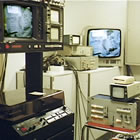A recent New York Times article delves into a topic not often discussed: the fact that some surgeons are more skilled than others. “A Vital Measure: Your Surgeon’s Skill” by Dr. Pauline W. Chen is a fascinating look at a taboo topic. Dr. Chen describes an innovative program where a group of expert surgeons judges how skilled a particular colleague is by looking at a close-up videotape of how he or she works with their hands, utilizes equipment, and so on. How can you tell if a surgeon is on his game? As famed sports commentator Warner Wolf would say in his catch-phrase, “Let’s Go to the Videotape!”

Video control room in an early angioplasty live demonstration course
However, watching procedures on video is nothing new to me, or to any member of the interventional cardiology community. The field of angioplasty started on Day One with live demonstration courses where procedures were performed utilizing live TV broadcasts (see my video at the bottom of this post). I designed and directed many of these early courses and we focused cameras on the operator’s hands, very similar to the videos in Dr. Chen’s article. And just last week at the TCT 2013 Annual Symposium, thousands of cardiologists watched the hands of their colleagues in HD video on a 100 foot screen, being broadcast from Germany, or South Korea, or New York.
In our video courses we showed more than just hands: we showed the fluoroscopic images, the ECG tracings, wider shots of the catheterization laboratories, extreme close-ups of the devices, atherectomy catheters, balloons, stents. We did everything we could to put the audience inside the room where the angioplasty was being performed, to allow the doctors to see how the tips of wires were shaped by hand to match the curve of the artery, how guide catheters were eased through the coronary vasculature, and so on.
Like the evaluators in Dr. Chen’s article, I too had the opportunity to see some incredibly skilled work…and then, occasionally, some slightly less-skilled work. I quickly learned the difference. I’m not a doctor (although I play with them on TV) but more than once I turned to a cardiologist who might be standing behind me to say something like, “Shouldn’t the guide wire be more distal to the lesion before the balloon is inflated?”, only to get a silent nod and upward roll of the eyes.
My point here is that interventional cardiologists “grew up” having cameras broadcasting their hand movements and technique to their peers.
Also, in the beginning years at least, it was not just the master cardiologists teaching the audience; these broadcasts were two-way affairs. Very often, if the operator was having difficulty, he might ask the audience for suggestions. “Who thinks I should switch to a Judkins Left? Maybe an Amplatz?” Sometimes these suggestions were made even though unsolicited, because the cardiologist in the audience had faced a similar problem. These courses were true learning experiences.
Oh yes, what about sports?
Dr. Chen ends her article with a reference to sports and how “some individuals might be naturally more talented at surgery, like some people are better at music or athletics.” Doctors on the playing field. And in the case of the live courses I directed, it was not so far from reality. Directing such courses was not unlike directing a sporting event, because it was live — no retakes. In fact virtually my entire video team regularly worked the baseball and football games because they were among the few technicians who understood “live TV.” I was told, in fact, that just for variety’s sake, when my crew was working on an SF Giants game, they began to use medical terms when referring to a baseball maneuver: the double play became a “catheter exchange.”
Surgery, stents and sports.
Below is a short 4 minute video I made about the history of the live demonstration course. It was created for the 2009 CRT symposium, held annually in Washington, DC. and was the kick-off for an FDA panel discussion of the ethics of such courses. It starts with John E. Abele, Founder Chairman (retired) of Boston Scientific, discussing how Andreas Gruentzig came up with the idea to use video.



